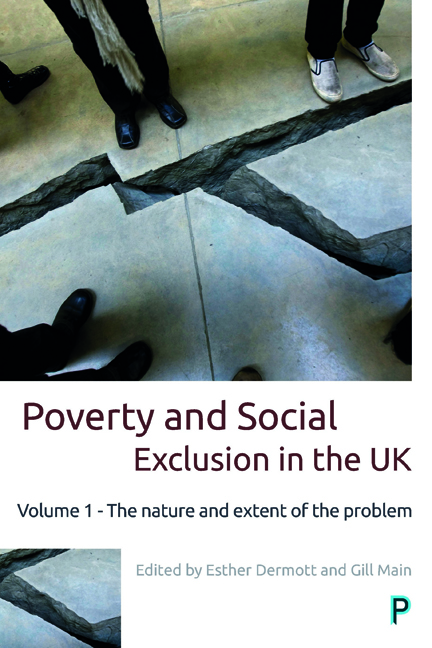Book contents
- Frontmatter
- Dedication
- Contents
- List of tables and figures
- Notes on contributors
- Acknowledgements
- Introduction: poverty and social exclusion in the UK
- One Measuring poverty in the UK
- Two The impoverishment of youth: poverty, deprivation and social exclusion among young adults in the Uk
- Three Improvement for some: poverty and social exclusion among older people and pensioners
- Four Which men and women are poor? Gender, poverty and social exclusion
- Five Better understandings of ethnic variations: ethnicity, poverty and social exclusion
- Six Improving lives? Child poverty and social exclusion
- Seven The cost of children: parents, poverty, and social support
- Eight A worsening picture: poverty and social exclusion and disabled people
- Nine Devolution and North/South division: poverty and social exclusion in the countries and regions of the UK
- Ten More similarities than differences: poverty and social exclusion in rural and urban locations
- Conclusion: innovating methods, informing policy and challenging stigma
- Technical appendix
- Index
Introduction: poverty and social exclusion in the UK
Published online by Cambridge University Press: 08 April 2022
- Frontmatter
- Dedication
- Contents
- List of tables and figures
- Notes on contributors
- Acknowledgements
- Introduction: poverty and social exclusion in the UK
- One Measuring poverty in the UK
- Two The impoverishment of youth: poverty, deprivation and social exclusion among young adults in the Uk
- Three Improvement for some: poverty and social exclusion among older people and pensioners
- Four Which men and women are poor? Gender, poverty and social exclusion
- Five Better understandings of ethnic variations: ethnicity, poverty and social exclusion
- Six Improving lives? Child poverty and social exclusion
- Seven The cost of children: parents, poverty, and social support
- Eight A worsening picture: poverty and social exclusion and disabled people
- Nine Devolution and North/South division: poverty and social exclusion in the countries and regions of the UK
- Ten More similarities than differences: poverty and social exclusion in rural and urban locations
- Conclusion: innovating methods, informing policy and challenging stigma
- Technical appendix
- Index
Summary
Poverty and social exclusion in the UK
The results of the Poverty and Social Exclusion 2012 survey (PSE-UK 2012) present a staggering picture of poverty in the UK today. There is little disagreement that in the 21st-century poverty is a serious social problem in one of wealthiest countries in the world. Over one hundred years since Rowntree wrote that ‘in this land of abounding wealth, during a time of perhaps unexampled prosperity, probably more than one fourth of the population are living in poverty, is a fact which may well cause great searchings of heart’ (1901, p 304), the problem of poverty in the UK has not been solved. As Julia Unwin, ex-chief executive of the Joseph Rowntree Foundation, has written ‘current levels of poverty are neither acceptable nor inevitable’ (Derbyshire, 2013, p 5).
A third of households are deprived of three or more items that are necessary for an adequate standard of living. Significant proportions of the population lack the most basic items – adequate housing, food and clothing. Our main findings show that:
• 10% of households (2.7 million) live in a damp home;
• 9% of households (2.3 million) cannot afford to heat the living areas of their home;
• 8% of adults (3.5 million) cannot afford two meals a day, fresh fruit and vegetables once a day, and or meat, fish or vegetarian equivalent every other day;
• 4% of children (0.5 million) do not have three meals a day, fresh fruit and vegetables once a day, and or meat, fish or vegetarian equivalent every day because their families cannot afford them;
• 9% of adults (4 million) cannot afford either or both a warm, waterproof coat and two pairs of all-weather shoes;
• 9% of children (1 million) go without necessary clothing (warm winter coat, new properly fitting shoes, some new clothes, four pairs of trousers) because of a lack of money.
Very large numbers of people cannot afford basic social activities and are financially insecure. Almost 12 million people are too poor to engage in common social activities and almost half of all adults (30 million) lack one of the four financial necessities (being able to pay an unexpected cost of £500; saving £20 a month for a rainy day; make regular payments into a pension; afford household insurance).
- Type
- Chapter
- Information
- Poverty and Social Exclusion in the UK Vol 1The Nature and Extent of the Problem, pp. 1 - 16Publisher: Bristol University PressPrint publication year: 2017
- 2
- Cited by



